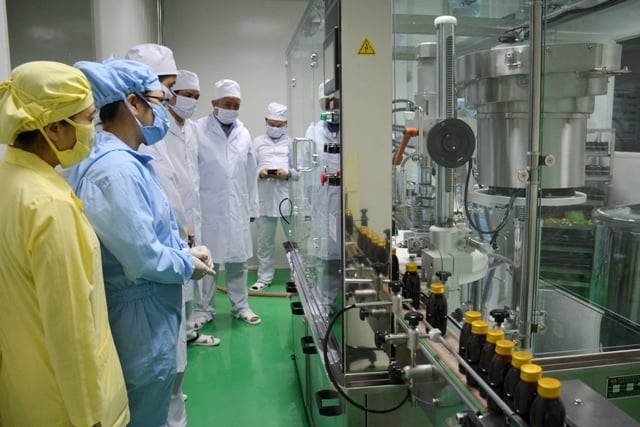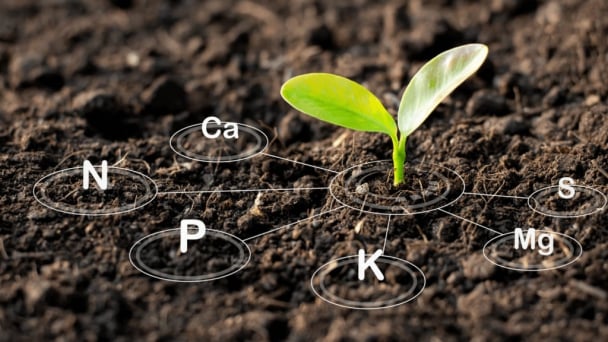May 21, 2025 | 10:33 GMT +7
May 21, 2025 | 10:33 GMT +7
Hotline: 0913.378.918
May 21, 2025 | 10:33 GMT +7
Hotline: 0913.378.918

Leaders of Quang Ninh province visit a booth displaying herbal medicine in the One Commune One Product (OCOP) program. These products have been exported to Japan. Photo: Anh Thang.
Ba Che district in the province is famous for its medicinal herbs. Up to 30 out of 1,027 species recorded in the locality have high economic value namely ba kich (morinda officinalis), tra hoa vang ( Camellia Chrysantha), nam lim xanh (Ganoderma lucidum ) and ha thu o do (Radix of Fallopia multiflora).
Hoanh Bo mountain district in the northern province of Quang Ninh is famous for its medicinal herbs, a specialty of the Dao ethnic minority people. Local people have worked hard to make Quang Ninh one of the centers of medicinal herbs in Vietnam.
For thousands of years, people of Ba Che have collected precious herbal plants from the wild such as morinda officinalis, Camellia Chrysantha and Ganoderma lucidum for usage and sale on the domestic market. However, the production of medicinal plants in the district was mainly conducted on a household scale.
Due to increasing demand for medicinal herbs, supporting policies and a big market consumption, the area of medicinal plants has increased rapidly.
Ba Che district now has 243ha of medicinal herbs. Camellia Chrysantha accounted for the largest cultivation area with 146ha, followed by purple morinda officinalis with 75ha.
According to Vi Thanh Vinh, head of the district’s Agricultural Division said the production of herbal medicine of ethnic minorities in the areas is on a small scale and spontaneous. There is no linkage between the production and consumption of the products.
“It is the customs and habit of exploiting medicinal plants without long-term calculation, seriously affecting the diversity and sustainability of the plants,” he said.
Therefore, investment in pharmaceutical processing technology was important to ensure the quality of medicinal herbs on sale in the market.
Attention should be paid to the post-harvest process to ensure the active ingredient content in medicinal herbs, Vinh said.
The district has only one cooperative specializing in producing morinda officianalis and Ganoderma lucidum wine, a private enterprise engaging in purchasing and processing Camellia Chrysantha. It also has a cooperative group engaged in Dao herbal bath but there isn’t any unit taking charge of processing complete medicinal herbs. As the medicinal plants are processed manually, their quality might be affected.
To deal with the issue, since 2015, Ba Che district has built a center for nursery and processing of Camellia Chrysantha at Dap Thanh Commune. Dap Thanh Forest Production Joint Stock Company is assigned to manage the nursery garden and tea processing factory.
Each year the company supplies over 80,000 Camellia Chrysantha seedings of all kinds, processing 15.5 tonnes of fresh tea leaves and 1.5 tonnes of fresh camellia. The district authority also applies special mechanisms and policies for businesses, cooperatives, individuals, and households that have to pour investment in medicinal herb development and processing.
The district has signed a memorandum of understanding with such businesses as MEDIPLANTEX Central Pharmaceutical Joint Stock Company for cooperation in the cultivation, processing, consuming products, and investing in medicinal plant growing areas of 200 hectares in line with World Health Organisation guidelines on good agricultural and collection practice (GACP-WHO).
To have high-quality and high-value herbal medicines, Quang Ninh Province has supported the people and localities with favorable natural conditions to cultivate the plants following the Government guidelines.

A pharmaceutical production line from medicinal herbs of Quang Ninh Pharmaceutical and Medical Material Joint Stock Company which has met the GMP-WHO standard. Photo: Ba Che Healthcare Centre.
Considering the linkage between agricultural and pharmaceutical cooperatives as key to expand production and build a global value chain for material areas and enterprises, a union was set up in late 2019. After two years of establishment, Quang Ninh Union of Agricultural and Pharmaceutical Cooperative has promoted its roles, facilitating members in the production process and businesses through a well-organized production scale.
Le Van Ha, director-general of the Quang Ninh Union of Agricultural and Pharmaceutical Cooperative, said the union has collaborated with Food Industry Institute under the Ministry of Industry and Trade and Sachalnchi Vietnam JSC in producing nearly 20 products from sachi, hibiscus, and Chùm ngây ( Moringa Oleifera) trees.
The alignment of agricultural pharmaceutical development cooperatives has contributed to promoting synergy, helping members to expand production and increase competitiveness. It has created stable jobs for people in rural areas as well as contributed to the poverty alleviation, economic development, social security, and environmental protection of the region.
In the future, the union will continue to invest in high-quality products and apply the fourth Industrial Revolution’s technologies to achieve sustainable production, meeting the market demand on agricultural and pharmaceutical products and towards export to overseas markets, he said.
Translated by Mai Hien

(VAN) Facing the threat of rabies spreading to the community, Gia Lai province urgently carries out measures to vaccinate dogs and cats on a large scale.

(VAN) Disease-free livestock farming not only protects livestock herds but also stabilizes production and livelihoods for many farmers in Tuyen Quang.

(VAN) Japan's grant aid project contributes to capacity building, promoting organic agricultural production, and fostering sustainable community development in Dong Thap province.

(VAN) For years, the CRISPR-Cas9 genome technology has been reshaping genetic engineering, a precision tool to transform everything from agriculture to medicine.

(VAN) Vietnam aims to become a 'leader' in the region in the capacity and managing effectively soil health and crop nutrition.
![Reducing emissions from rice fields: [Part 1] Farming clean rice together](https://t.ex-cdn.com/nongnghiepmoitruong.vn/608w/files/news/2025/05/05/z6509661417740_a647202949c539012a959e841c03e1d3-nongnghiep-143611.jpg)
(VAN) Growing clean rice helps reduce environmental pollution while increasing income, allowing farmers to feel secure in production and remain committed to their fields for the long term.
/2025/05/19/5136-1-144800_230.jpg)
(VAN) The Nghe An Provincial People's Committee has just approved the list of beneficiaries eligible for revenue from the Emission Reductions Payment Agreement (ERPA) in the North Central region for the year 2025.